
Original Link: https://www.anandtech.com/show/2260
Enzotech Ultra-X: If Looks Could Chill
by Wesley Fink on June 27, 2007 3:00 AM EST- Posted in
- Cases/Cooling/PSUs
It is not likely that Enzotech will be a name familiar to computer enthusiasts. However, some IT professionals will probably recognize the name as a manufacturer of highly respected cooling solutions for servers. While Enzotech has been manufacturing cooling solutions since 1982, the Ultra-X is their first venture into an air-cooling solution for desktop computers.
Located in Walnut, California, Enzotech continues to manufacture server cooling components. There are even several 1U cooler designs available to the general public that can be seen at the Enzotech website. The main items that will likely be of interest to AT readers will be the full line of passive cooling solutions for the Northbridge, VGA card and memory. The subject of this review, the Enzotech Ultra-X, is also generating interest among computer enthusiasts.
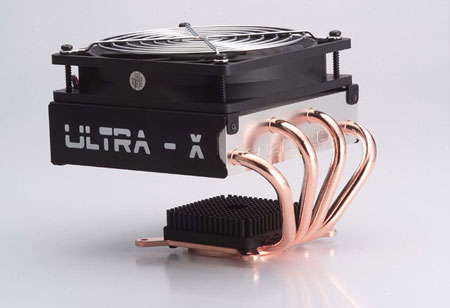
Many readers asked us to take a closer look at the Ultra-X cooler, and it is clear why they have been impressed with the Ultra-X. The cooler is beautifully finished and clearly made with careful attention to quality. Many have also claimed this to be the best performing air cooler on the market.
If indeed this is the best air cooler you can buy the Enzotech would also break a pattern we have seen in recent cooler reviews. The Ultra-X is a down-facing fan heatpipe cantilever. That class of coolers has not performed quite as well as our top heatpipe towers in our cooling tests.
If the Enzotech does top our cooling charts then it will certainly prove the down-facing coolers can perform at top levels. On the other hand, if the Enzotech performs similarly to other down-facers like the Thermaltake Big Typhoon VX, the Scythe Andy Samurai, the Thermaltake MaxOrb, and the Cooler Master GeminII it will simply further the evidence suggesting such designs are not quite as efficient.
Enzotech Ultra-X
The Ultra-X comes in a matte black and silver package with a side window that highlights the heatpipe cantilever.
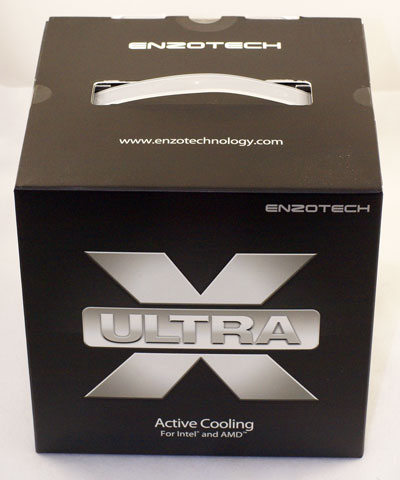
All the information you need to make a buying decision is on the box - specifications, included accessories, CPU compatibility, etc. The only thing missing is a quick trip to AnandTech to check out how the cooler compares to others in cooling efficiency. Inside the package is a clear plastic molded clamshell that protects the individual components.
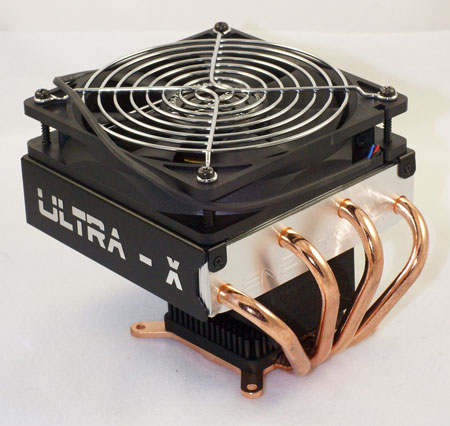
The cooler is designed around a high output down-facing fan blowing across a large cantilever of horizontal heatpipes cooled by vertical aluminum fins. The fin array is enclosed on all sides. Heatpipes extend from a base that is also cooled by another small heatsink to the heatpipe cantilever
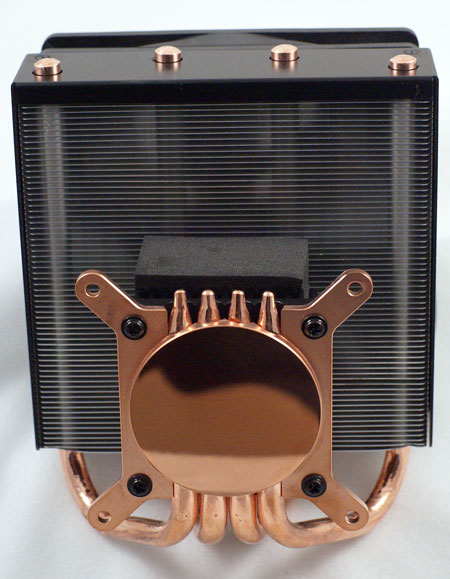
Enzotech prominently features the mirror-finished copper base in all their literature. They claim the base is machined to 0.0003 per inch run out, "which optimizes surface contact and maximizes thermal conductivity performance". The mirror finish is certainly an excellent execution of machining. Our performance tests will better indicate whether it really makes any difference in performance.
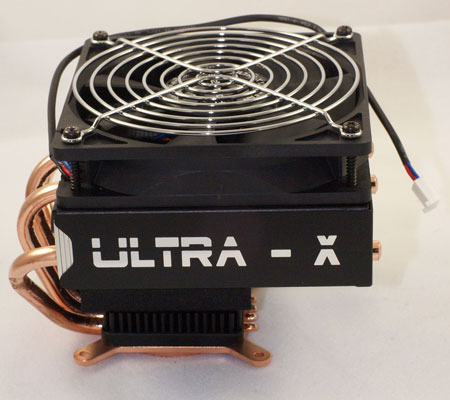
The Ultra-X fan is a stock Delta fan controlled by a variable speed rheostat that can mount in an available card slot. This allows control of the fan speed even if the case is closed. Many of us remember Delta fans from AMD socket A days where the Delta delivered incredible air output at the price of extreme noise. This Delta claims output as high as 82.7 CFM at a less than quiet 38.5dbA. We will be measuring noise performance and reporting it compared to other tested coolers on p. 7.
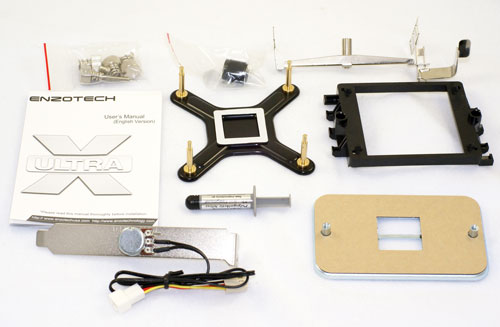
Accessories include a mounting base and spring loaded screws for Intel socket 775 and a complete base, cage and clip for AMD sockets. Mounting of either Intel or AMD processors is very simple. Also included is a small syringe of premium Arctic Silver 5, and very clear installation instructions. Mounting is simple and very secure with either 775 or AMD. However, you will have to remove the motherboard to install the cooler - at least on Intel 775. While the motherboard is removed to place the base through the 4-holes in the 775 motherboard, go ahead and mount the spring screws. It can be really difficult to try to tighten these after the board is remounted.
Should you require further help with the installation process, Enzotech provides very clear installation videos for both Intel and AMD in the Ultra-X section of their website. While the Ultra-X is a very heavy cooler at 835g it is good to see strong and effective installation options available with the cooler. Ultra-X was very secure on both 775 and AMD sockets, providing peace of mind when mounting this heavy cooler on an expensive motherboard.
The Enzotech Ultra X is one of the more expensive coolers we have tested. Web prices ranged from $63 to $65. Enzotech distributes their products through specialty cooling shops, so you will not find them at volume resellers. Our sincere thanks go to Frozen CPU for arranging a retail review sample of the Ultra-X. We would not have been able to turn a review around so quickly without their help.
Specifications
Our test system is Intel socket 775, but the Ultra-X will also mount on any recent AMD socket as well - including 754/939/940 and AM2. The Enzotech kit includes the back plate, cage, and mounting clip for AMD processors. All the needed hardware is included, and installation is even easier than the 775 install - particularly on a mounted motherboard.
| Enzotech Ultra-X Specifications | ||||
| Heatsink | ||||
| Dimensions | 148(W) X 148(D) X 118(H)mm | |||
| Weight | 835g | |||
| Material | Mirror-Polished Copper Base and Aluminum Fins | |||
| Heatpipes | Four 8mm copper heatpipes | |||
| Fan | ||||
| Fan Size | 120 x120x 25mm | |||
| Bearing Type | 2-ball Delta AFB1212H-FOO | |||
| Connector | 3-pin with integral fan-speed rheostat | |||
| Speed | Lo Speed | 1,200rpm | Hi Speed | 2,500rpm |
| Noise Level | Lo Speed | 24.5dBA | Hi Speed | 38.5dBA |
| Fan Output | Lo Speed | 35.8cfm | Hi Speed | 82.67cfm |
The Ultra-X is relatively large, but it is shorter in height than most of the heatpipe tower coolers. The heatpipe cantilever overhangs the base, so you can also cool a Northbridge or hot power transistors depending on how you mount the cooler. Enzotech did not provide recommended orientations for the cooler for various case designs.
The EVGA 680i is a difficult to fit board due to the copper-finned heatsink and fan cooling the Northbridge. The Enzotech fit comfortably but clearances required mounting the cooler out of the case before mounting the motherboard in the case. Installation was also an easy task on the ASUS Striker and ASUS Commando, and on the two new ASUS P35 boards - the P5K Deluxe and P5K3 Deluxe. The P5K3 Deluxe will likely become a fit test for any motherboard, since the heatpipes completely circle the CPU socket and connect various cooling heatsinks around the CPU socket.
CPU Cooling Test Configuration
The standard test bed for cooling tests is the EVGA NVIDIA 680i SLI motherboard. This is primarily based on the consistent test results on this board and the NVIDIA Monitor temperature measurement utility, which is part of the nTune program.
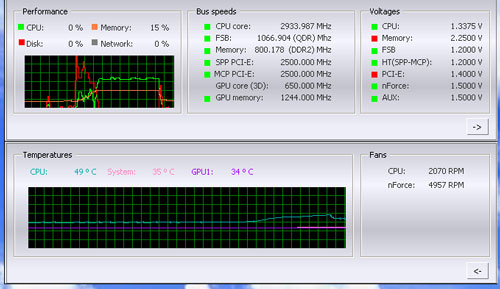
NVIDIA Monitor has a drop-down pane for temperature measurement which reports CPU, System, and GPU measurement. At this point reviews will concentrate on CPU temperature. In addition to the real-time temperature measurement, NVIDIA Monitor also has a logging feature which can record temperature in a file in standard increments (we selected every 4 seconds). This allows recording of temperatures during testing, which can then be reviewed when the stress tests are completed. There is also the handy reference of speeds and voltages in the top pane to confirm setup.
NVIDIA Monitor was compared to test results from the Intel TAT (Thermal Analysis Tool). Intel TAT CPU portions do function properly on the EVGA 680i motherboard, but the chipset-specific features do not operate as they should. Idle temperatures in TAT were in line with measured idle temps with NVIDIA Monitor. The CPU stress testing with TAT pushing both cores showed TAT stress temps at 80% CPU usage roughly corresponded to temps reported in our real-world gaming benchmark.
Other components in the cooling test bed are generally the same as those used in our motherboard and memory test bed:
| Cooling Performance Test Configuration | |
| Processor | Intel Core 2 Duo X6800 (x2, 2.93GHz, 4MB Unified Cache) |
| RAM | 2x1GB Corsair Dominator PC2-8888 (DDR2-1111) |
| Hard Drive(s) | Hitachi 250GB SATA2 enabled (16MB Buffer) |
| Video Card | 1 x EVGA 7900GTX - All Standard Tests |
| Platform Drivers | NVIDIA 9.53 |
| NVIDIA nTune | 5.05.22.00 (1/16/2007) |
| Video Drivers | NVIDIA 93.71 |
| CPU Cooling | Enzotech Ultra-X 3RSystem iCEAGE Thermaltake Big Typhoon VX Thermaltake MaxOrb Scythe Andy Samurai Master Cooler Master Gemini II Noctua NH-U12F ASUS Silent Square Pro Scythe Ninja Plus Rev. B OCZ Vindicator Thermalright Ultra-120 Extreme Thermalright Ultra-120 Scythe Infinity Zalman CNS9700 Zalman CNS9500 Cooler Master Hyper 6+ Vigor Monsoon II Lite Thermalright MST-9775 Scythe Katana Tuniq Tower 120 Intel Stock HSF for X6800 |
| Power Supply | OCZ PowerStream 520W |
| Motherboards | EVGA nForce 680i SLI (NVIDIA 680i) |
| Operating System | Windows XP Professional SP2 |
| BIOS | Award P26 (1/12/2007) |
All cooling tests are run with the components mounted in a standard mid-tower case. The idle and stress temperature tests are run with the case closed and standing as it would in most home setups. We do not use auxiliary fans in the test cooling case, except for the Northbridge fan attached to the 680i for overclocking. Room temperature is measured before beginning the cooler tests and is maintained in the 20 to 22C (68 to 72F) range for all testing.
Enzotech provided a small tube of premium Arctic Silver 5 with the cooler accessories, but we tested the Ultra-X with our standard premium silver-colored thermal compound. In our experience the thermal compound used makes little to no difference in cooling test results. This is particularly true now that processors ship with a large manufacturer-installed heatspreader. Our current test procedure uses this standard high-quality silver-colored thermal paste for all cooler reviews.
We test the stock Intel cooler at standard X6800 speed, measuring the CPU temperature at idle and while the CPU is being stressed. The CPU is stressed by running continuous loops of the Far Cry River demo. The same tests are repeated at the highest stable overclock we can achieve with the stock cooler. Stable in this case means the ability to handle our Far Cry looping for at least 30 minutes.
The same benchmarks are then run on the cooler under test at stock, highest stock cooler OC speed (3.73GHz), and the highest OC that can be achieved in the same setup with the cooler being tested. This allows measurement of the cooling efficiency of the test unit compared to stock and the improvement in overclocking capabilities, if any, from using the test cooler.
Noise Levels
In addition to cooling efficiency and overclocking abilities, users shopping for CPU cooling solutions may also be interested in the noise levels of the cooling devices they are considering. Noise levels are measured with the case on its side using a C.E.M. DT-8850 Sound Level meter.
This meter allows accurate sound level measurements from 35bdB to 130dB with a resolution of 0.1dB and an accuracy of 1.5dB. This is sufficient for our needs in these tests, as measurement starts at the level of a relatively quiet room. Our own test room, with all computers and fans turned off, has a room noise level of 36.4dB.
Procedures for measuring cooling system noise are described on page 7 which reports measured noise results comparing the stock Intel cooler and recently tested CPU coolers to the Enzotech Ultra-X.
Cooling at Stock Speed
Some users will never overclock their CPU, but they still want to run the coolest CPU temperatures possible to enhance stability and extend CPU life. The Enzotech Ultra-X comes with a high-quality slot-mounted rheostat coupled to a high-output Delta fan. Therefore we tested the Ultra-X cooler with the supplied fan and rheostat.
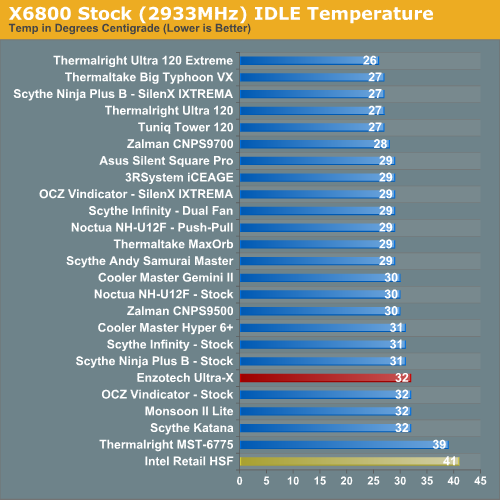
Where the very good Intel stock cooler keeps the X6800 at 41C at idle, the Ultra-X manages 32C. This is a significant improvement over the Intel stock cooler performance, but the results are average at best. The Thermalright coolers, at the top of our heatpipe tower performance charts, cool to 26C and 27C, and the Tuniq 120 maintains 27C.
It is more difficult to effectively simulate a computer being stressed by all of the conditions it might be exposed to in different operating environments. For most home users CPU power is most taxed with contemporary gaming. Therefore our stress test simulates playing a demanding game.
The Far Cry River demo is looped for 30 minutes and the CPU temperature is captured at 4 second intervals with the NVIDIA Monitor "logging" option. The highest temperature during the load test is then reported. Momentary spikes are ignored, as we report a sustained high-level temp that you would expect to find in this recording configuration. This test configuration roughly equates to an 80% CPU load test using Intel TAT.
Cooling efficiency of the Enzotech Ultra-X is then compared under load conditions at stock speed to the retail HSF and other recently tested CPU coolers.
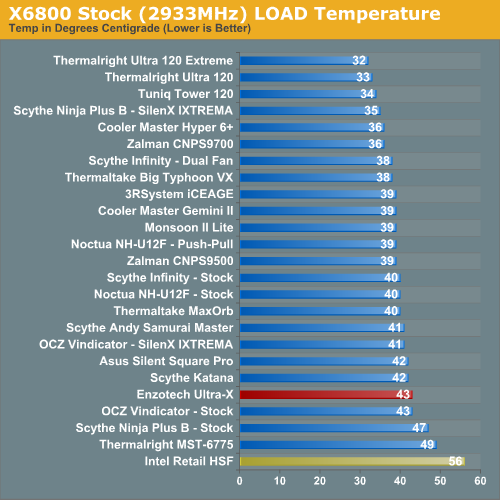
The Ultra-X under load at stock speeds reached a maximum temperature of 43C with the included fan at its highest speed. This compares to the Thermalrights at 32C and 33C, the Tuniq at 34C, and the Cooler Master Hyper 6+ and Zalman 9700 at 36C. Stock load performance is below average among tested coolers, a pattern we have consistently seen with downward-blowing designs.
Scaling of Cooling Performance
The Ultra-X performance was average at stock idle and below average among top coolers at stock load. As overclocks are raised, the Enzotech exhibits improved performance in the ability to cool the CPU under stress conditions. To be as fair as possible all overclocking tests were run with the Enzotech fan at the highest speed.
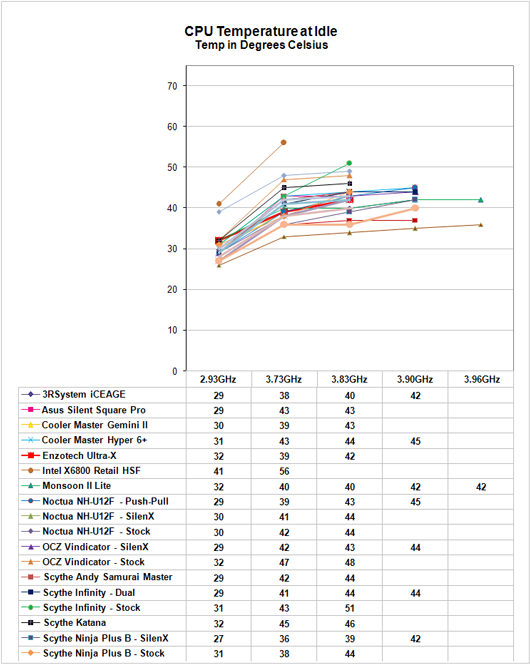 |
| Click to enlarge |
At 2.93GHz the retail HSF is running at 41C, compared to 32C with the Ultra-X. This is a delta of 9C. The delta becomes greater as the overclock increases. At 3.73GHz the idle with the retail fan is 56C compared to the Ultra-X at 39C - a delta of 17C. The cooling performance of the Enzotech is much better than the Intel retail cooler at idle, but the Ultra-X does not reach the same cooling levels measured with the Thermalrights (with a Scythe S-Flex SFF21F fan) or the stock Tuniq 120. The top Thermalright Ultra-120 eXtreme, for example is at 33C at the same 3.73GHz.
We also need to compare cooling efficiency of the Enzotech Ultra-X under load conditions to the retail HSF and other recently tested CPU coolers. Load testing can be very revealing of a cooler's efficiency. A basically flat line, particularly form 3.73GHz upward, indicates the cooler is still in its best cooling range. A line that is increasing rapidly indicates a cooler nearing the end of its ability to cool efficiently. Lines which parallel the best coolers over a range of values are indicate that the coolers have similar cooling efficiency.
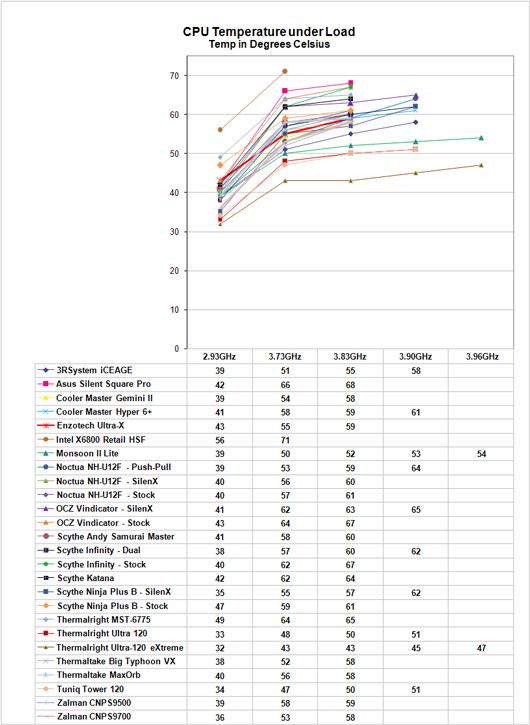 |
| Click to enlarge |
The Ultra-X is very efficient in cooling in the 2.93 GHz to 3.73 GHz overclock range. As you can see in the chart the cooling is almost a horizontal line in this range. The Enzotech continues on to a highest overclock of 3.86GHz, which is short of the 3.90GHz to 3.94GHz most of the top coolers in our testing have achieved. These results are similar to other down-facing coolers. While the overclock is the best we have seen with a down-facing cooler, they are still below the top heatpipe towers. The slope of the Ultra-X in this range from 3.73GHz to 3.86GH is steeper than the heatpipe towers, indicating it is nearing the end of its range of efficient cooling.
Unfortunately, the Ultra-X is not in the same cooling category as the best heatpipe towers we have tested. We hoped this cooler might be the down-facing cooler to buck the trend, but that is not the case. Ultra-X is a decent cooler to the range just below the best, but cooling efficiency is similar to other down-facing heatpipe towers tested.
As stated many times, the overclocking abilities of the CPU will vary at the top, depending on the CPU. This particular CPU does higher FSB speeds than any X6800 we have tested, but the 3.90GHz top speed with the Tuniq is pretty average among the X6800 processors we have tested with Tuniq cooling. A few of the other processors tested with the best air coolers reach just over 4 GHz, but the range has been 3.8 to 4.0GHz. Stock cooling generally tops out 200 to 400 MHz lower, depending on the CPU, on the processors tested in our lab.
Overclocking
As cooling solutions do a better job of keeping the CPU at a lower temperature, it is reasonable to expect the overclocking capabilities of the CPU will increase. In each test of a cooler we measure the highest stable overclock of a standard X6800 processor under the following conditions:
CPU Multiplier: 14x (Stock 11x)
CPU voltage: 1.5875V
FSB Voltage: 1.30V
Memory Voltage: 2.20V
nForce SPP Voltage: 1.35V
nForce MCP Voltage: 1.7V
HT nForce SPP <-> MCP: Auto
Memory is set to Auto timings on the 680i and memory speed is linked to the FSB for the overclocking tests. This removes memory as any kind of impediment to the maximum stable overclock. Linked settings on the 680i are a 1066FSB to a memory speed of DDR2-800. As the FSB is raised the linked memory speed increases in proportion. The same processor is used in all cooling tests to ensure comparable results.
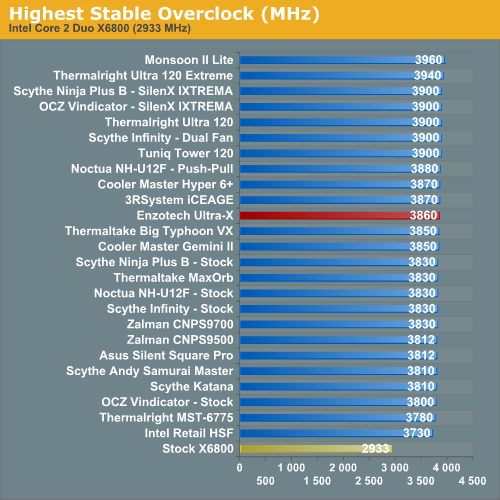
The Enzotech Ultra-X reaches a stable 3.86 GHz - again similar to other down-facing coolers. This is high enough to make the Ultra-X the best overclocking down-blowing cooler we have tested, but it does not match the 3.90 to 3.94GHz measured with the best heatpipe towers.
Many readers have suggested that an auxiliary case fan exhausting air out the back of the case will improve performance of the down-facing fan coolers. As an additional check we mounted an Aero Cool 120mm Xtreme Turbine fan at the rear of the case exhausting air form the case interior. This fan is capable of air flows up to 89 CFM.
The added case fan did cool temperatures by as much as 4 to 5C at stock 2.93 GHz, and 1 to 3C at 3.83 GHz. This did provide somewhat better cooling with the Ultra-X. However, we could not achieve a higher overclock with the Ultra-X with the added high-output case fan. The highest stable overclock was still 3.86GHz.
Noise
For many enthusiasts upgrading cooling the goal is maximum stable overclock, and they will live with the inconvenience of a louder system. For other users silence is the most important factor, and these users will forgo maximum overclocking if that increases system noise levels. Let's see how the Ultra-X compares with the other coolers we've tested in this area.
There are very few power supplies that do not have a fan. While Zalman and a few others do make expensive fanless power supplies, we have not seen a fanless unit larger than 500W, or one that would be used for seriously overclocking a system. With that in mind the noise level of the system with all fans turned off except the PSU was measured. The power supply used for the cooling test bed is the OCZ PowerStream 520, which is one of the quieter high performance power supplies.
We have also measured the Corsair 620W and Mushkin 650W power supplies which are reported to be quieter than the OCZ. Both the Corsair and Mushkin are indeed quieter at idle or start up speed. However, as soon as load testing begins and the PSU fan speed kicks up the measured noise level is almost exactly the same as the OCZ PowerStream 520W.
We are currently in the process of reevaluating our cooler test bed and planning some updates. The new configuration will include a "quieter" power supply with variable speed and noise levels. We will also update to a P35 chipset motherboard with all passive cooling to the chipset. Changes to the test bed will appear as part of a future roundup with the motherboard, PSU, and CPU all upgraded to more current configurations. We are also investigating a change to a quad-core processor as a further challenge to CPU cooling.
The noise level of the power supply is 38.3 dB from 24" (61cm) and 47 dB from 6" (152mm). The measured noise level of the test room is 36.4 dB, which is a relatively quiet room with a noise floor slightly below that of the OCZ PowerStream 520 PSU.
Noise levels were measured with the Enzotech Ultra-X fan at both low 1200 RPM speed and high 2500 RPM speeds. Both low and high measurements were taken at both the 6" and 24" distances above the cooling fan on an open case side. Results were then compared to the other coolers/fans tested in this category. Measured noise levels in this chart should be considered worst case. Measurements were taken with an open side of a mid tower case 6" and 24" from the HSF. Real world would be a completely closed case with a further reduction in noise. Please look for both low and high speed results in the noise graphs.
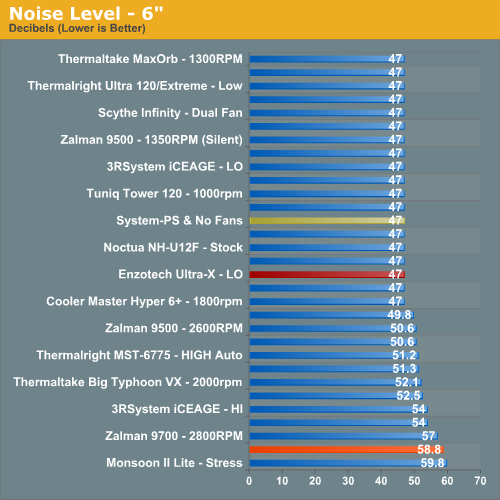
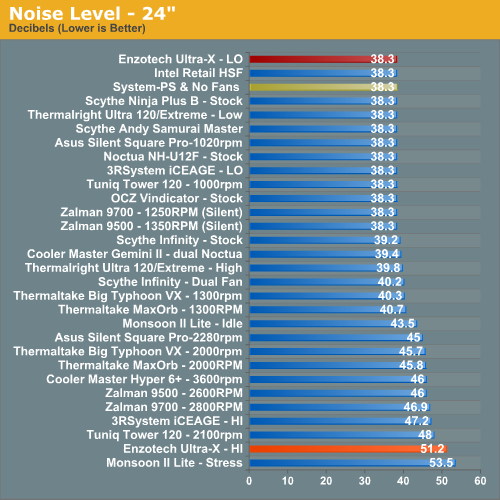
The measured noise levels at 6" and 24" do nothing to convince us that Delta fans are now quiet. When turned down to the lowest speed noise levels are below the noise floor, but air output is a fairly mediocre 35.8 CFM. Increasing fan speed to high raises CFM to a very respectable 83.7, but the price is noise levels that are clearly audible and among the poorest we have measured at 51.2 dB(A) at 24". There are other fans available that cool better at lower noise. Fortunately it is pretty easy to switch the stock fan for a quieter fan if that is your goal.
The Delta fan does provide a very wide range of cooling output, but there are better fans that provide higher output at lower noise at both the low and high output ranges. To our ears noise from the Delta fan was audible over much of the specified range. Overall noise results with the Delta fan are disappointing. There are many fans with similar output ranges - or even greater ranges - that are much quieter than the Delta used by Enzotech.
Conclusion
It would have been great to see the Enzotech Ultra-X top our cooling test results. This is not because we have a bias in favor of Enzotech, but because a cooler as beautifully finished as the Ultra-X deserves recognition. Unfortunately the best we can say about the Enzotech is that it is the best of the down-facing coolers by a small margin in overclocking, which is a notch below the top-performing heatpipe towers. This is certainly not bad performance, but it is not the best we have tested at AnandTech.
Nothing we have measured in this review of the Enzotech Ultra-X has changed our opinion of the influence of air cooler design on cooler performance. The heatpipe towers with side-facing fans are the top-performing coolers we have tested, in both overclocking ability and cooling efficiency. The best designs with down-facing fans perform in a second tier category just below the top heatpipe towers. The Enzotech Ultra-X performs in that category. That means the top of the air cooler list is still the domain of the Thermalrights, Tuniq Tower 120, and a few push-pull configured towers.
This makes the Ultra-X a beautifully built gem of a cooler with solid engineering of the installation kits for Intel 775 and AMD. The Enzotech is relatively easy to install, but you will have to remove the motherboard to install the Ultra-X. Like many other top coolers the Enzotech Ultra-X is heavy at 835g, but the installation is solid on every motherboard we tried. This is a cooler that attaches to the board securely enough that you won't worry about the cooler falling off when you least expect it. Ultra-X is still a big cooler and you will need to take precautions when moving your system, but the install is solid.
The fan choice for the Ultra-X, however, is not a particularly good selection. It is very noisy at highest speed, where it is most effective at cooling. At lowest speed it is reasonably quiet, but the output borders on anemic. Look back through our reviews of coolers and choose a fan that better balances air output and noise. Fortunately almost any 25mm thick 120mm fan can be mounted on the Ultra-X (though that's an additional cost to an already pricey cooler). Another plus is that the included rheostat for varying fan speed will work on almost any fan with a 3-pin connector, and that means it can be used with almost any 120mm fan.
We really appreciate the obvious quality that went into the manufacturing of the Enzotech Ultra X. The mirror finish mounting base is a very satisfying sight compared to the rough, poorly-machined surfaces seen on far too many coolers today. However, it is hard to argue for mirror-finishes and thoughtful well-engineered installations when you can't find any performance improvements. In the end the Ultra-X still suffers from the same shortfalls as other down-facing coolers, and its cooling efficiency is not even as good as a few of the better down-facers. Overclocking fares a bit better, but then we have a noisy obtrusive fan. If you admire quality production you will like the Ultra-X, but the performance and noise levels still leave a lot to be desired. This is particularly true when you factor in that the Enzotech Ultra-X is one of the more expensive air coolers we have tested. There are better values available in the air cooling market.







